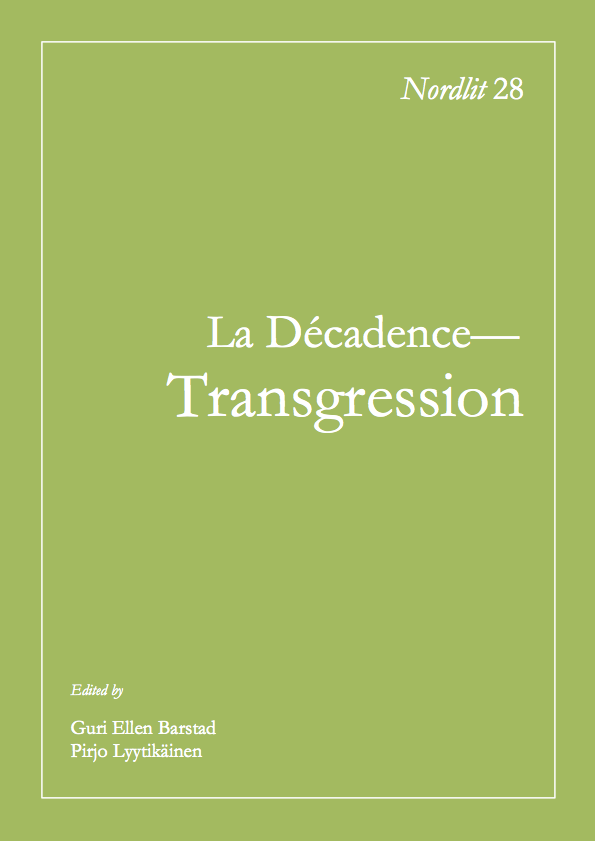Decadence in the Wilderness. Will to Transgression or the Strange Bird of Finnish Decadence
DOI:
https://doi.org/10.7557/13.2062Keywords:
Dionysian Decadence, transgression, devil, femme fatale, maniaAbstract
The decadence that the Decadents identified in their own civilization was recognized through the model of Roman Empire, although they thought that the Romans were, even in their decadence, much more vigorous than the modern "cerebral" decadents. The figures of the late Empire, which fused the over-ripeness of culture with barbarism, were great even in their decline; the ancient uninhibited transgressions and vices fascinated the decadents although even the imagined debaucheries exhausted the modern decadents. Des Esseintes is, of course, a paradigmatic figure, connecting extreme weakness and fragility of the nervous system with wild sadistic dreams. He is capable of producing vigorous mental images, imagining sublimely horrible figures and emblems of disease, which fell on a fertile ground in later decadent writings.
At the same time, the idea of the savage and the primitive which had underwent a radical change, when the romantic idea of the noble savage was replaced by the primitive as the lowest order of humanity, became fashionable even among many Decadents. This debauched barbarian or savage (whose representatives or relics the survived "primitive cultures" were) marked the beginnings of human culture and was the suppressed foundation of all developed cultures. The danger of the return of this primitive side of man could threaten even the most civilized individuals or nations if the ties and restraints of culture were loosened (Joseph Conrad's Heart of Darkness represents this perfectly). For the decadents, who did not see their own civilization in the terms of progress any more, and embraced ideas of entropy, dissolution and return to a state of new barbarism, the idea of the decline of their culture, thus, could become connected with the idea of the primitive "in us", the primitive lurking in the psyche of every individual and the primitive that was built in the culture itself. As the primitive became, increasingly, identified not only with "primitive peoples" or "primitive races" mostly inhabiting in the colonies or far-out regions, but with groups within the civilized society, like workers, paupers, lower classes, Jews or even women, it was easy to find seeds and forces of the foreseen and, at the same time, feared development.
When these ideas were connected with Nietzscheanism, like in the early novels by the Finnish author Joel Lehtonen, they produced a provocative form of Dionysian Decadence; a manic form of decadence combining primitive energies with provocative questioning of traditional cultural values. It was Nietzsche himself who suggested the idea that the "tropical man" or the primitive seen as the evil to be eradicated by the moralists should be recognized as a potentially positive force (Beyond Good and Evil, 197). Lehtonen's decadent figures (especially in his novel Mataleena 1905) find their roots in the primitive life of the Finnish "wilderness" and connect this primitiveness to a provocative decadence, which is à rebours, against all recognized cultural values but has power only as a form of deconstruction and destruction.
Downloads
Published
How to Cite
Issue
Section
License
Forfattere som publiserer i dette tidsskriftet aksepterer følgende vilkår:
- Forfattere beholder copyright og gir tidsskriftet retten til første publisering samtidig som verket lisensieres med en Creative Commons Attribution 4.0 International lisens som tillater andre å dele verket, forutsatt at verkets forfatter og første publisering i tidsskriftet erkjennes.
- Forfattere kan inngå separate, ikke-eksklusive avtaler om annen distribusjon av tidsskriftets publiserte utgave av verket (f.eks. egenarkivering i et vitenarkiv eller publisering i en bok), så lenge førstepubliseringen i tidsskriftet erkjennes.
- Forfattere tillates og oppmuntres til å gjøre verket tilgjengelig på nettet (f.eks. i et vitenarkiv eller på andre nettsider) før og under innlevering, da dette kan lede til nyttige menings- og kunnskapsutvekslinger og til tidligere og mer sitering av det publiserte verket. (Se The Effect of Open Access).









